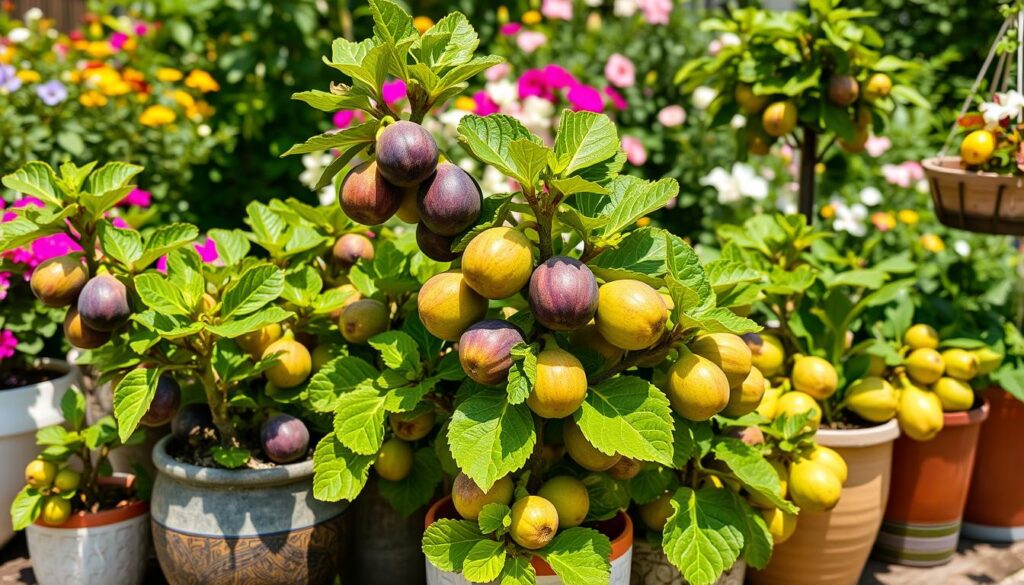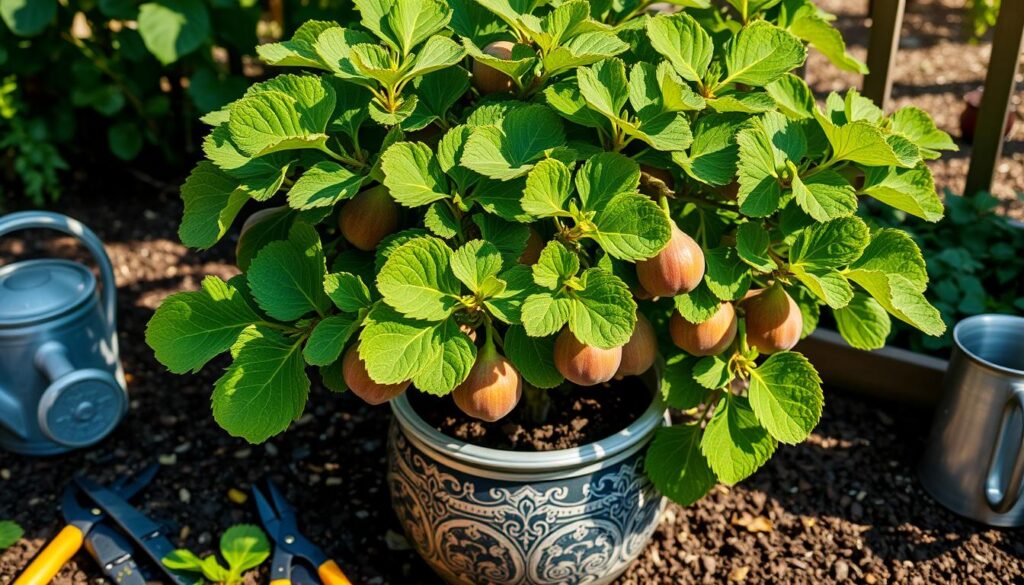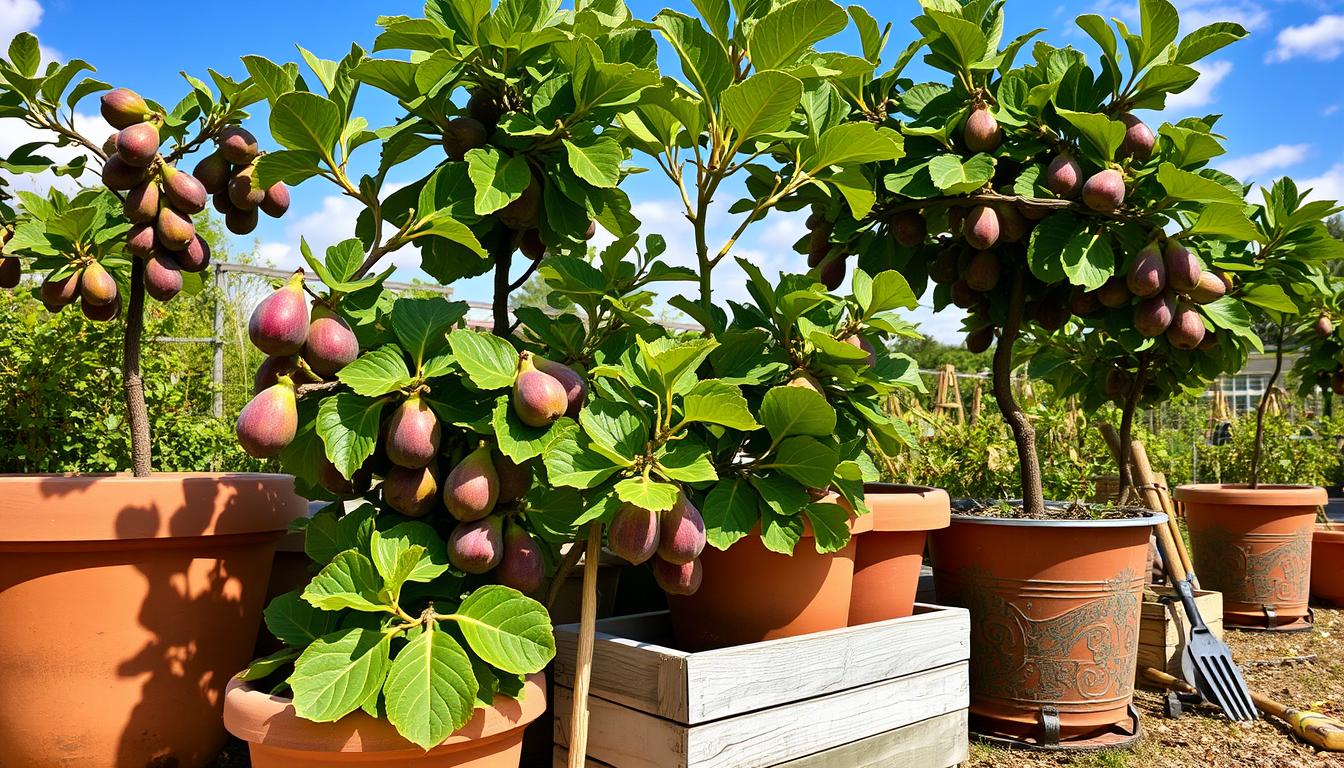Growing figs in containers is a great way for gardeners to enjoy these tasty fruits, even with little space. This guide will help you learn everything about growing fig trees in pots. Fig trees can start producing fruit in just 1-2 years, offering quick results for gardeners.
If you live in a cold area, like zone 6 or below, container gardening is especially helpful. By using pots, you can move your fig trees inside during winter. This keeps them safe from frost and prevents root rot. You’ll find out how to pick the right containers and care for your fig trees, no matter where you live.
Let’s dive into the basics of growing figs in containers. With this guide, you’ll be able to grow your own figs, even with limited space or location.
Key Takeaways
- Fig trees produce fruit within 1-2 years, making them quick to harvest.
- Container sizes range from 5-10 gallons initially and can expand to 2.5 feet in diameter for mature trees.
- Regular pruning helps maintain container fig trees between 6-8 feet tall.
- Figs thrive in full sun, requiring at least six to eight hours of direct sunlight daily.
- Moving fig trees indoors during cold months helps protect them from frost.
- Potted fig trees can yield two harvests annually, mainly in late summer.
Introduction to Growing Figs in Containers
Growing figs in containers is great for those without much outdoor space. It lets me control the environment of my indoor fig trees. This way, I can enjoy fresh fruit all year round.
One big plus of growing how to grow figs in pots is how easy it is to move them. I can put them in the best spots for sunlight or to protect them from bad weather. In hot summers, they need almost half a gallon of water every day.
It’s important to water them right, as too much water can cause root rot. Not enough water can make them drop their fruit. Keeping the soil just right is key.
Keeping the soil’s pH between 6 and 7.5 is crucial. The Fignomenal variety is perfect for containers, growing only 28 inches tall. It does well in a 24-inch pot and gives delicious figs with enough sunlight and warmth.
Learning how to grow figs in pots brings many benefits. I can enjoy the fruits of my labor, whether indoors or outdoors.
The Ultimate Guide to Growing Figs in Containers
Growing figs in containers is a great way to enjoy these tasty fruits, no matter where you live. Fig trees, part of the Ficus family, do well in many places. Knowing their natural homes helps us meet their needs in small spaces.
Understanding Fig Trees and Their Habitats
Fig trees are not only pretty; they also grow fruit quickly. They start producing fruit in 1-2 years, which is faster than many other trees. In colder areas, like zone 6 and colder in the U.S., growing figs in containers is a good choice. This way, I can move them inside when it gets too cold.
Benefits of Growing Figs in Containers
Container gardening with fig trees has many benefits. Containers can be moved to avoid bad weather, which is great for city gardens. I can pick the best spot for my fig trees, making sure they get what they need.
Containers for fig trees are usually 5 to 7 gallons, up to 2.5 feet wide. But, bigger containers can be hard to move because they’re so heavy. Keeping the trees small, 6 to 8 feet tall, is easier for home gardens. It’s important to water them often, especially in the summer.
Gardenbeginner.com helps beginners learn about plant care, including fig trees. With the right info, I can make sure my fig trees grow well and give me plenty of fruit.
| Fig Varieties | Growing Zones | Mature Size |
|---|---|---|
| Brown Turkey Fig Tree | 7 to 10 | About 20 feet tall and wide |
| Celeste Fig Tree | 7 to 10 | 5 to 10 feet tall and wide |
| Chicago Hardy Fig Tree | 5 to 10 | 15 to 30 feet tall and wide (smaller in cooler areas) |
| Little Miss Figgy | 7 to 10 | 4 to 6 feet tall and 3 to 4 feet wide |
In summary, with the right care, figs can grow well in containers. This makes gardening more fun and adds to my cooking options.
Choosing the Right Container for Your Fig Tree
Choosing the right container is key for your fig tree’s health, especially on patios. The size and material of the pot affect growth and fruit. Knowing your tree’s needs helps pick the best container.
Ideal Pot Sizes for Different Age Groups
The pot size matters based on the tree’s age and yield. Young trees do well in smaller pots, while older trees need more room. Here are some pot size recommendations for different ages:
| Age Group | Recommended Pot Size | Expected Yield |
|---|---|---|
| Seedlings (1-2 years) | 3-5 gallons | 50-75 figs |
| Young Trees (2-3 years) | 10-15 gallons | 100-200 figs |
| Mature Trees (3+ years) | 14-20 inches or larger | 150+ figs |
Bigger pots help trees take in more nutrients, leading to more fruit. Fig trees often start producing fruit in 1-2 years, so the right pot size is crucial for quick results.
Best Materials for Fig Containers
There are several materials for fig containers, each with its own benefits:
- Clay: Breathes well but can cause root problems and needs pruning.
- Plastic: Light and comes in many sizes, but watch for root issues.
- Ceramic: Looks good and is strong, but can be heavy and hard to move.
- Fabric: Helps with air pruning and drainage, but may need to be replaced.
It’s important to ensure the container drains well to avoid root rot. Too much water can turn leaves yellow. For me, having a container with good drainage, like gravel or built-in systems, is reassuring.

Planting Fig Trees in Containers
Planting fig trees in containers needs careful timing and a good plan. The best times to plant are early spring and fall. This helps the trees grow well and adjust to their new home. Knowing how to grow figs in pots can make your trees thrive and give you yummy fruit.
Optimal Planting Times
Wait until the frost danger has passed to plant your fig trees. This is usually in late spring. In colder places, a container makes it easier to move the tree when it gets too cold.
Step-by-Step Planting Guide
Here’s how to plant your container figs successfully:
- Choose a pot that’s 6 to 8 inches wider than the nursery pot. As the tree grows, switch to bigger containers, 15 to 20 gallons.
- Make a soil mix that drains well. Adding perlite or sand to potting soil helps a lot.
- Take the fig tree out of its nursery pot carefully. Be gentle with the roots.
- Put the tree in the middle of the new pot. Fill around the roots with soil mix, making sure it’s at the same level as before.
- Water the tree a little to settle the soil. But don’t soak it. Check the soil moisture in the top 1-2 inches to water right.
- Put the pot in a sunny spot. Make sure it gets at least 6 hours of bright light every day.
By following these tips for successful container figs, you can help your fig trees grow strong and produce fruit.
| Step | Description |
|---|---|
| 1 | Select a pot size of 6 to 8 inches wider than the nursery pot. |
| 2 | Prepare a well-draining soil mix with potting soil, perlite, or sand. |
| 3 | Carefully remove the fig tree from its nursery pot. |
| 4 | Center the tree in the container and fill around it with soil. |
| 5 | Water lightly to settle the soil without over-saturation. |
| 6 | Place the pot in a sunny location with at least 6 hours of sunlight. |
Soil Requirements for Container Fig Trees
Proper soil is key for healthy fig trees in containers. They need a well-draining mix to avoid waterlogged roots. I mix materials that help with aeration and keep moisture right.
Creating a Well-Draining Soil Mix
I blend ingredients for the best soil mix for my fig tree. This mix includes:
- Organic compost for nutrients
- Perlite for better drainage
- Peat moss or coir to hold moisture
This mix is airy, which is good for a healthy root system. Blonde peat is especially good because it has more air pockets.
Recommended Soil Amendments
To make the soil even better, I add:
| Soil Amendment | Benefits |
|---|---|
| Vermiculite | Keeps moisture in |
| Fine Bark Chips | Improves air flow |
| Rice Hulls | Helps with drainage |
| Worm Compost | Rich in nutrients |
| Composted Seafood Waste | Boosts nutrients |
These additions help the soil and feed the plant. A custom mix for fig trees can improve growth and fruiting.
Caring for Your Potted Fig Tree
It’s important to give your potted fig tree the right care for it to grow well and produce fruit. Paying attention to how much water and sunlight it gets is key. This helps your fig tree stay healthy and avoid diseases and pests.
Watering Techniques for Container Fig Care
Fig trees in pots need to be watered more often than those in the ground. In the summer, they might need water every day to stay moist. But, don’t overwater, as it can cause root rot.
Water your fig tree for about 15 minutes each morning. This lets the roots soak up the water without getting too wet.
Sunlight Needs for Healthy Growth
The amount of sunlight your fig tree gets is very important. It should have 4 to 8 hours of direct sunlight each day. This is especially true for varieties like ‘Petite Negra,’ which need at least 8 hours to grow well.
If you live in a cooler area, move your fig tree indoors when the leaves start to fall. This helps it rest during the winter. Watching the conditions closely can help avoid problems with diseases and pests.

For more tips on growing potted fig trees, including how to plant and care for different varieties, check out this in-depth article. Knowing what your tree needs can make your gardening journey successful, leading to plenty of fruit and a thriving garden.
Best Fig Varieties for Container Gardening
Choosing the right fig varieties is key to growing figs on patios. Some figs do well in containers, perfect for small spaces or city gardens. There are hardy and delicate types, each suited for different climates and fruit tastes.
Recommended Varieties for Different Climates
It’s important to think about climate zones when picking figs. Some figs can handle cold, while others need warmth. Here are some top picks:
| Fig Variety | Climate Zone | Key Features |
|---|---|---|
| Brown Turkey Fig | Zones 5-10 | Versatile and prolific, produces sweet fruit. |
| Chicago Hardy Fig | Zones 5-10 | Cold-hardy, good for colder climates, reliable producer. |
| Petite Negra | Zones 7-11 | Dwarf variety, ideal for small containers, standard-size figs. |
| Peter’s Honey Fig | Zones 8-10 | Sweet, honey-like flavor, good for warmer climates. |
Flavor Profiles to Consider
Figs come in a variety of flavors, offering something for everyone. You might find:
- Berry: Sweet and fruity, like strawberries or blackberries.
- Honey: Naturally sweet, with a rich and syrupy finish.
- Sugar: Mild sweetness, great for eating fresh.
Choosing flavors that match your taste and use can make your fig experience better. These varieties not only taste great but also beautify your space. For more tips or questions, visit the Contact page.
Pruning and Maintenance of Fig Trees in Containers
Pruning is key for fig trees in containers to stay healthy and productive. It helps control their size, encourages growth, and prevents overcrowding. Prune in late winter when the trees are dormant. This guide will cover the best pruning strategies and tips for growing figs in containers.
When and How to Prune
Pruning shapes your fig tree and boosts its growth and fruit. The container size affects how tall the tree can grow. Prune to keep it between 6-8 feet tall. Start with strategic cuts in the early growing seasons to build a strong structure.
This ensures the tree gets enough sunlight for photosynthesis. Better sunlight means better fruit quality and more harvests.
Tips for Maintaining a Manageable Size
To keep your fig tree healthy and balanced in a container, follow these tips:
- Use rejuvenation pruning to promote new growth by removing weak or unproductive branches.
- Save lateral buds to keep the tree growing well by maintaining hormonal balance.
- Use staking to support the tree and improve photosynthesis, which boosts fruit quality.
- Watch the tree’s growth and prune as needed to avoid overcrowding and ensure sunlight reaches all parts.
- Apply mulch after planting to keep moisture in and reduce watering needs in summer.
| Pruning Technique | Purpose | Impact on Growth and Production |
|---|---|---|
| Rejuvenation Pruning | Encourages new growth | Improves tree health and productivity |
| Structural Pruning | Shapes the tree for sun exposure | Enhances photosynthesis and fruit yield |
| Staking | Supports growth and structure | Increases fruit quality and maximizes sunlight |
| Selective Pruning | Removes unproductive branches | Maintains energy for fruit-bearing wood |
Using these pruning methods helps grow strong, healthy fig trees. Each method has a special role in keeping your container-grown fig trees thriving and productive.
Dealing with Pests and Diseases in Container Figs
Keeping my container fig trees healthy means watching out for pests and diseases. These threats can harm my plants. I’ll share common pests and how to prevent them to keep my figs thriving.
Common Pests to Watch For
Container fig trees often face pests like fungus gnats. These gnats are about 4 mm long and have a 21-day life cycle at 24°C. Their larvae can damage young fig roots.
- Aphids – These small insects can weaken the tree by sucking sap.
- Scale – These pests attach themselves to stems and leaves, affecting the tree’s overall health.
- Fungus gnats – As previously mentioned, these pests are notorious for their root-damaging larvae.
Preventative Measures for Tree Health
To protect my container figs, I focus on good care. I use a mix of strategies to keep them healthy. Key steps include:
- Proper watering to avoid too much moisture, which pests like. Yellow leaves mean I’m watering too much.
- Keeping air moving around the plants to stop fungal problems.
- Using organic treatments like nematodes to fight fungus gnat larvae.
- Using BT for pest control.
- Checking for pests with yellow sticky cards.
By following these steps, I keep my fig trees healthy all year. This way, I enjoy fresh figs without worrying about pests.
| Pest | Impact | Control Method |
|---|---|---|
| Aphids | Weaken tree, sap-sucking | Organic insecticidal soap |
| Scale | Affects health by sucking sap | Horticultural oil spray |
| Fungus Gnats | Damages roots | Nematodes, BT, yellow sticky cards |
Conclusion
Growing figs in containers is a fun and rewarding hobby for gardeners. It combines the joy of growing plants with the pleasure of eating fresh fruit. By choosing the right variety, like Brown Turkey or Celeste, and following key tips, my fig trees can grow well in small spaces.
Fig trees not only produce delicious fruit but also make my garden look beautiful. They add a special touch to my backyard or patio.
Understanding how fig trees grow is key to success. They have two fruiting phases, with the main crop ready in late August. To get the most fruit, I make sure they have good soil, enough sunlight, and no pests.
For those ready to try growing figs in containers, this guide is a great start. It covers everything from planting to harvesting. I also find helpful tips and advice here to improve my growing skills.



Leave a Reply